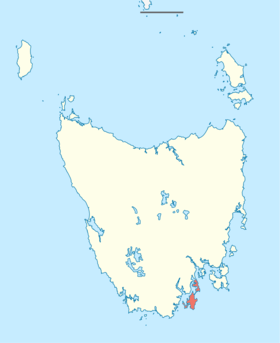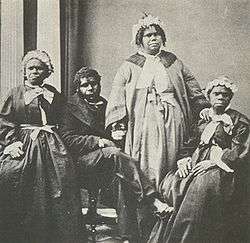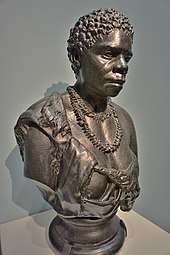Truganini
Truganini (c. 1812 – 8 May 1876) was a woman widely considered to have been the last full-blooded Aboriginal Tasmanian, although she was outlived by Fanny Cochrane Smith (1834–1905).
Truganini (Trugernanner) | |
|---|---|
_p187_TASMANIA%2C_THE_LAST_OF_THE_ABORIGINALS_(LADY).jpg) Truganini in 1870. | |
| Born | c. 1812 |
| Died | 8 May 1876 (aged 63–64) |
| Other names | Truganini, Trucanini, Trucaninny, and Lallah Rookh "Trugernanner" |
| Known for | Last surviving full-blooded Aboriginal Tasmanian and terminal speaker of the Nuenonne language |
| Spouse(s) | Woorrady |
There are a number of other spellings of her name, including Trugernanner, Trugernena, Truganina, Trugannini, Trucanini, Trucaminni,[lower-alpha 1] and Trucaninny.[lower-alpha 2] Truganini was also widely known by the nickname Lalla(h) Rookh.[lower-alpha 1]
Early life

Truganini was born about 1812[2] on Bruny Island (Lunawanna-alonnah), located south of the Van Diemen's Land capital Hobart and separated from the Tasmanian mainland by the D'Entrecasteaux Channel.[3] She was a daughter of Mangana, Chief of the Bruny Island people. Her name was, in the Bruny Island language (Nuennonne), the name of the grey saltbush Atriplex cinerea.[4]
In her youth she took part in her people's traditional culture, but Aboriginal life was disrupted by European settlement. When Lieutenant-Governor George Arthur arrived in Van Diemen's Land in 1824, he implemented two policies to deal with the growing conflict between settlers and the Aboriginals. First, bounties were awarded for the capture of Aboriginal adults and children, and secondly an effort was made to establish friendly relations with Aboriginals in order to lure them into camps. The campaign began on Bruny Island where there had been fewer hostilities than in other parts of Tasmania.

When Truganini met George Augustus Robinson, the Chief Protector of Aborigines, in 1829, her mother had been killed by sailors, her uncle shot by a soldier, her sister abducted by sealers, and her fiancé brutally murdered by timber-cutters, who then repeatedly sexually abused her. In 1830, Robinson moved Truganini and her husband, Woorrady, to Flinders Island with the last surviving Tasmanian Aboriginals, numbering approximately 100. The stated aim of isolation was to save them, but many of the group died from influenza and other diseases. In 1838 Truganini also helped Robinson to establish a settlement for mainland Aboriginals at Port Phillip.[5] After about two years of living in and around Melbourne, she joined Tunnerminnerwait and three other Tasmanian Aboriginals as outlaws, robbing and shooting at settlers around Dandenong, which triggered a long pursuit by the authorities. The outlaws moved on to Bass River and then Cape Paterson. There, members of the group murdered two whalers at Watson's hut. The group was captured and sent for trial for murder at Port Phillip, and a gunshot wound to Truganini's head was treated by Dr Hugh Anderson of Bass River. The two men of the group were found guilty and hanged on 20 January 1842.[6] Truganini and most of the other Tasmanian Aboriginals were returned to Flinders Island several months later. In 1856, the few surviving Tasmanian Aboriginals on Flinders Island, including Truganini, were moved to a settlement at Oyster Cove, south of Hobart.[7] According to The Times newspaper, quoting a report issued by the Colonial Office, by 1861 the number of survivors at Oyster Cove was only fourteen: "...14 persons, all adults, aboriginals of Tasmania, who are the sole surviving remnant of ten tribes. Nine of these persons are women and five are men. There are among them four married couples, and four of the men and five of the women are under 45 years of age, but no children have been born to them for years. It is considered difficult to account for this... Besides these 14 persons there is a native woman who is married to a white man, and who has a son, a fine healthy-looking child..." The article, headed "Decay of Race", adds that although the survivors enjoyed generally good health and still made hunting trips to the bush during the season, after first asking "leave to go", they were now "fed, housed and clothed at public expense" and "much addicted to drinking".[8]
Final years and legacy

Oral histories of Truganini report that after arriving in the new settlement of Melbourne and disengaging with Robinson, she had a child named Louisa Esmai with John Shugnow or Strugnell at Point Nepean in Victoria. Further, Truganini was from the bloodlines of Victoria's Kulin Nation tribes. Indeed, they hid the child from authorities hunting Truganini. After Truganini was captured and exiled, her daughter Louisa was raised in the Kulin Nation. Louisa married John Briggs and supervised the orphanage at Coranderrk Aboriginal Reserve when it was managed by Wurundjeri leaders including Simon Wonga and William Barak.[9][lower-alpha 3] Louisa was grandmother to Ellen Atkinson.
According to a report in The Times she later married a Tasmanian Aboriginal, William Lanne (known as "King Billy") who died in March 1869.[lower-alpha 1] By 1873, Truganini was the sole survivor of the Oyster Cove group, and was again moved to Hobart. She died three years later and was buried at the former Female Factory at Cascades, a suburb of Hobart.
Before her death Truganini had pleaded to colonial authorities for a respectful burial, and requested that her ashes be scattered in the D'Entrecasteaux Channel. She feared that her body would be mutilated for perverse scientific purposes as William Lanne's had been.[11] Despite her wishes, within two years, her skeleton was exhumed by the Royal Society of Tasmania and later placed on display.[12] Only in April 1976, approaching the centenary of her death, were Truganini's remains finally cremated and scattered according to her wishes.[13][14]
Truganini is often considered to be the last full-blood speaker of a Tasmanian language.[15] However, The Companion to Tasmanian History details three full-blood Tasmanian Aboriginal women, Sal, Suke and Betty, who lived on Kangaroo Island in South Australia in the late 1870s and "all three outlived Truganini". There were also Tasmanian Aboriginals living on Flinders and Lady Barron Islands. Fanny Cochrane Smith (1834–1905) outlived Truganini by 30 years and in 1889 was officially recognised as the last full-blood Tasmanian Aboriginal, though there was speculation that she was actually mixed-race.[16] Smith recorded songs in her native language, the only audio recordings that exist of an indigenous Tasmanian language.[2][17]
In 1997 the Royal Albert Memorial Museum, Exeter, England, returned Truganini's necklace and bracelet to Tasmania. In 2002, some of her hair and skin were found in the collection of the Royal College of Surgeons of England and returned to Tasmania for burial.[18]
In 1835 and 1836, settler Benjamin Law created a pair of busts depicting Truganini and Woorrady in Hobart Town that have come under recent controversy.[19] In 2009, members of the Tasmanian Aboriginal Centre protested an auction of these works by Sotheby's in Melbourne, arguing that the sculptures were racist, perpetuated false myths of Aboriginal extinction, and erased the experiences of Tasmania's remaining indigenous populations.[20] Representatives called for the busts to be returned to Tasmania and given to the Aboriginal community, and were ultimately successful in stopping the auction.[21]
Artist Edmund Joel Dicks also created a plaster bust of Truganini, which is in the collection of the National Museum of Australia.[22]
Truganini Place in the Canberra suburb of Chisholm is named in her honour.[23]
Cultural references
- "Truganini's Dreaming" is the title of a song written by Bunna Lawrie, the founding member, sole songwriter and lead singer of the Australian Aboriginal band Coloured Stone. It appeared on their 1986 album, Human Love, which won the Best Indigenous Release at the ARIA Music Awards of 1987.
- Truganinni, a play about her life by Melbourne writer Bill Reid, had its premiere at the Union Theatre, University of Melbourne on 21 April 1970, directed by George Whaley and starring Jan Hamilton as Truganinni.
- "Truganini" is the name of a song by Midnight Oil, from their 1993 album Earth and Sun and Moon; this song spoke partly of Truganini herself but also of what Midnight Oil saw as Australia's environmental and social problems.
- In the roman à clef Doctor Wooreddy's Prescription for Enduring the Ending of the World, one of the main characters is Trugernanna, a somewhat fictional portrayal of Truganini.
- A steamer called Truganini sailed in the South Seas in 1886, visiting Papua New Guinea.[24]
- A racehorse named "Truganini" ran in Britain in the early 20th century[25] and another named "Trucanini" started racing aged 2 in the 2012 season.
- The cruelty against Truganini receives explicit mention in Yuval Harari's Sapiens: A Brief History of Humankind.
- Truganani is the name of a song by Troy Kingi, from his 2019 album Holy Colony Burning Acres.
See also
- Black War
- Doctor Wooreddy's Prescription for Enduring the Ending of the World
- Tunnerminnerwait, leader and resistance fighter
Notes
- "A royal lady - Trucaminni, or Lallah Rookh, the last Tasmanian aboriginal, has died of paralysis, aged 73. She was Queen Consort to King Billy, who died in March 1871, and had been under the care of Mrs Dandridge, who was allowed £80 annually by the Government for maintenance."[1]
- Colonial-era reports spell her name "Trugernanner" or "Trugernena" (in modern orthography, Trukanana or Trukanina). In 1869 the town of Truganini was established near Bendigo in Victoria; in 1870 that spelling was first used for Truganini's name.
- According to the Australian Dictionary of Biography, Louisa Briggs was probably the daughter of Doog-by-er-um-boroke, a Woiorung woman kidnapped from Port Phillip by sealers.[10]
Citations
- The Times, Thursday, 6 July 1876; pg. 6; Issue 28674; col D
- Ryan & Smith 1976.
- Flannery 1994.
- Ellis, V. R. 1981. Trucanini: Queen or Traitor. Australian Institute of Aboriginal Studies. p.3
- The Andersons of Western Port Horton & Morris
- The Australasian Chronicle 1842, p. 2.
- Gough 2006.
- The Times, issue 23848 dated Tuesday, 5 February 1861; p. 10; col A
- Register of Births, Deaths & Marriages
- Barwick 2005.
- Australian Museum.
- Kühnast 2009.
- "The Last Wish: Truganini's ashes scattered in the D'Entrecasteaux Channel", Aboriginal News, vol. 3, no. 2, 1976
- DPAC Tasmania 2011.
- Crowley & Thieberger 2007.
- Roth 1898, pp. 451–454.
- Fanny Cochrane Smith.
- Barkham & Finlayson 2002.
- Hansen 2010.
- ABC News.
- Davies 2009.
- NMoA 1931.
- Gazette 1978, p. 14.
- The Times, Saturday, 24 April 1886; p. 4; Issue 31742; col E
- The Times, Thursday, 22 October 1908; p. 13; issue 38784; col A
Sources
- Barkham, P. & Finlayson, A. (31 May 2002). "Museum returns sacred samples". The Guardian. Retrieved 11 July 2006.
- Barwick, Laura (2005). "Briggs, Louisa (1836–1925)". Australian Dictionary of Biography. Melbourne University Press. ISSN 1833-7538. Retrieved 7 October 2015 – via National Centre of Biography, Australian National University.
- Crowley, Terry; Thieberger, Nick (2007). Field linguistics: a beginner's guide. Oxford University Press, USA.
- Davies, Caroline (16 September 2009). "Aborigines demand that British Museum returns Truganini bust". the Guardian. Retrieved 29 November 2015.
- "Fanny Cochrane Smith". Index of Significant Tasmanian Women. Department of Premier and Cabinet (Tasmania). Archived from the original on 19 July 2010. Retrieved 21 March 2012.
She is probably best known for her cylinder recordings of Aboriginal songs, recorded in 1899, which are the only audio recordings of an indigenous Tasmanian language.
- Flannery, Tim F. (1994). The Future Eaters: An ecological history of the Australasian lands and people. New York: Grove Press. ISBN 0-8021-3943-4.
- Gough, Julie (2006). "Oyster Cove". The Companion to Tasmanian History. Centre for Tasmanian Historical Studies, University of Tasmania.
- Hansen, David (May 2010). "Seeing Truganini" (PDF). Australian Book Review. Archived from the original (PDF) on 4 March 2016.
- Kühnast, Antje (2009). ""In the interest of science and the colony". Truganini und die Legende von den aussterbenden Rassen.". In Hund, Wulf D. (ed.). Entfremdete Körper: Rassismus als Leichenschändung [Alienated Bodies: Racism and the desecration of corpses]. Bielefeld: transcript Verlag. pp. 205–250. ISBN 978-3-8376-1151-9.
- "Plaster bust of Truganini by Edmund Joel Dicks". National Museum of Australia. 1931. Retrieved 21 November 2017.
- "Port Phillip". The Australasian Chronicle. Sydney, NSW. 15 February 1842. p. 2. Retrieved 27 March 2015.
- "'Racism not art': Anger at Truganini bust auction". ABC News. Retrieved 29 November 2015.
- Roth, Henry Ling (1898). "Is Mrs. F. C. Smith a 'Last Living Aboriginal of Tasmania'?". Journal of the Royal Anthropological Institute. 27: 451–454. JSTOR 2842841.
- Ryan, Lyndall; Smith, Neil (1976). "Trugernanner (Truganini) (1812–1876)". Australian Dictionary of Biography. 6. Melbourne University Press. ISSN 1833-7538. Retrieved 24 June 2013 – via National Centre of Biography, Australian National University.
- "Schedule 'B' National Memorials Ordinance 1928–1972 Street Nomenclature List of Additional Names with Reference to Origin". Commonwealth of Australia Gazette (Special (National: 1977–2012) ed.) (S24): 14. 8 February 1978 – via Trove.
- "Truganini". Index of Significant Tasmanian Women. Tasmania's Department of Premier and Cabinet. October 2011. Archived from the original on 28 October 2009. Retrieved 21 March 2012.
- "Truganini (1812?-1876)". Australian Museum. Retrieved 28 November 2015.
External links
| Wikimedia Commons has media related to Truganini. |
- The Last of the Tasmanians on Wikisource
- Truganini (1812–1876) National Library of Australia, NLA Trove, People and Organisation record for Truganini
- Images of Truganini in State Library of Tasmania collection
- Alexander, Alison Truganini at Companion to Tasmanian History, University of Tasmania
- Russell, John (Essay) The Representation of Trucanini 1999. at fotoworkz freelance photographic
- (Article) Truganini's Funeral
- (Radio Feature) Truganini – Bushranger
- (Article) Truganini (1812?–1876) A life reflecting the tragic history of the first Tasmanians.